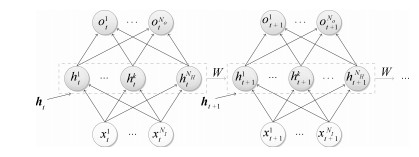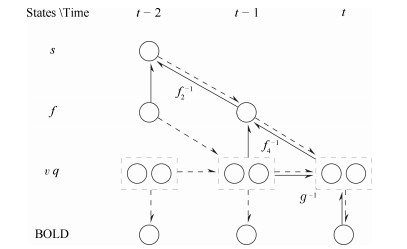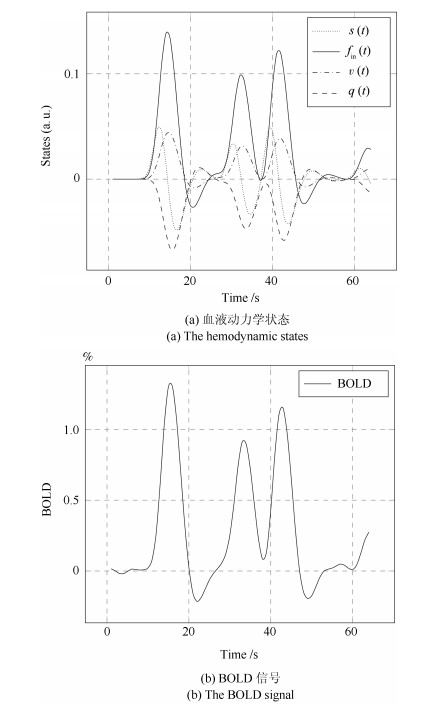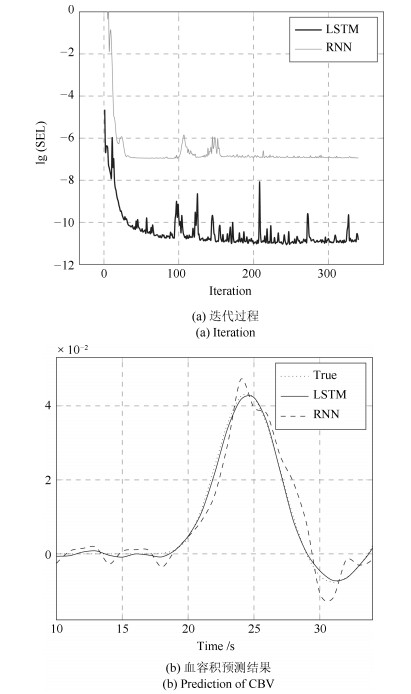Estimation of Hemodynamic States Based on Stacked Recurrent Neural Network in fMRI Time Series
-
摘要: 利用fMRI数据准确地估计血液动力学状态, 能得到一种更接近神经元层面的大脑活动的客观表示, 这将促进人们对大脑运行机理的深刻理解, 推动脑认知的进一步发展.迄今为止, 人们已经提出了许多血液动力学状态估计方法.然而, 这些方法大都只考虑了相邻时刻血液动力学状态之间的关系, 忽视了更深层次的时序特征.而对模型参数先验信息的需求也使一些方法在实际应用中受到了限制.为此, 本文提出了一种基于循环神经网络的血液动力学状态估计新方法.首先, 利用血液动力学模型中非线性函数的反函数建立BOLD信号与血液动力学状态之间的映射关系, 并构建模型的反演过程.然后, 采用一种堆叠三个RNN模块的栈式神经网络结构来拟合这种映射关系, 使其能够以BOLD信号作为输入, 得到血液动力学状态的估计值.最后, 在仿真数据上验证新方法的性能.实验结果表明:与一些代表算法相比, 新方法能够更合理地提取fMRI数据中的时间特性, 有效地拟合BOLD信号与血液动力学状态之间的动态非线性关系.Abstract: The estimation of underlying hemodynamic states from the fMRI data can provide an objective representation of the brain activity at the neuronal level, which can contribute to the understanding of the brain operation mechanism and the development of the brain cognition research. So far, many methods have been proposed for estimating hemodynamic states from the fMRI data. However, most of these methods are limited to the further consideration of the temporal characteristic in the hemodynamic model. In addition, they require the prior knowledge on hemodynamic model parameter values, which are not measurable in the actual situation. Therefore, this paper presents a new approach based on recurrent neural network (RNN) to carry out the estimation of hemodynamic states, which employs RNN to extract the temporal features inherent in fMRI time series. Firstly, the inversion process has been constructed by the inversions of nonlinear functions in the hemodynamic model, which map the BOLD signal to hemodynamic states. Then, a novel neural network architecture called stacked recurrent neural network (SRNN) is used for estimating hemodynamic states with BOLD signals by approximating the mapping relations. Finally, the experimental results on the simulated data have shown that the new approach can not only capture the temporal characteristic in the fMRI data, but also can model the nonlinear relationship between hemodynamic states dynamically.
-
Key words:
- Recurrent neural network (RNN) /
- functional magnetic resonance imaging (fMRI) /
- hemodynamic model /
- hemodynamic state /
- neural activity
1) 本文责任编委 谭营 -
表 1 血液动力学模型参数默认值
Table 1 The default value of hemodynamic model parameters
Parameters Description Default $ \epsilon $ Neural efficiency 0.50 $ \kappa $ Rate of signal decay 0.65 $ \gamma $ Rate of flow dependent elimination 0.41 $ \tau $ Hemodynamic transit time 0.98 $ \alpha $ Grubb's exponent 0.32 $ E_0 $ Resting oxygen extraction fraction 0.34 $ V_0 $ Resting blood volume fraction 0.08 表 2 时间性能比较
Table 2 The comparison of time performance
-
[1] Logothetis N K. The underpinnings of the BOLD functional magnetic resonance imaging signal. Journal of Neuroscience, 2003, 23(10): 3963-3971 doi: 10.1523/JNEUROSCI.23-10-03963.2003 [2] Ogawa S, Lee T M, Kay A R, Tank D W. Brain magnetic resonance imaging with contrast dependent on blood oxygenation. Proceedings of the National Academy of Sciences of the United States of America, 1990, 87(24): 9868-9872 doi: 10.1073/pnas.87.24.9868 [3] Aguirre G K, Zarahn E, D'Esposito M. The variability of human, BOLD hemodynamic responses. NeuroImage, 1998, 8(4): 360-369 doi: 10.1006/nimg.1998.0369 [4] Friston K J, Holmes A P, Worsley K J, Poline J P, Frith C D, Frackowiak R S J. Statistical parametric maps in functional imaging: a general linear approach. Human Brain Mapping, 1994, 2(4): 189-210 doi: 10.1002-hbm.460020402/ [5] Gitelman D R, Penny W D, Ashburner J, Friston K J. Modeling regional and psychophysiologic interactions in fMRI: the importance of hemodynamic deconvolution. NeuroImage, 2003, 19(1): 200-207 doi: 10.1016/S1053-8119(03)00058-2 [6] David O, Guillemain I, Saillet S, Reyt S, Deransart C, Segebarth C, et al. Identifying neural drivers with functional MRI: an electrophysiological validation. PLoS Biology, 2008, 6(12): e315 doi: 10.1371/journal.pbio.0060315 [7] Roebroech A, Formisano E, Goebel R. The identification of interacting networks in the brain using fMRI: model selection, causality and deconvolution. NeuroImage, 2011, 58(2): 296-302 doi: 10.1016/j.neuroimage.2009.09.036 [8] Friston K J, Mechelli A, Turner R, Price C J. Nonlinear responses in fMRI: the Balloon model, Volterra kernels, and other hemodynamics. NeuroImage, 2000, 12(4): 466-477 doi: 10.1006/nimg.2000.0630 [9] Buxton R B, Wong E C, Frank L R. Dynamics of blood flow and oxygenation changes during brain activation: the balloon model. Magnetic Resonance in Medicine, 1998, 39(6): 855-864 doi: 10.1002/mrm.1910390602 [10] Friston K J, Josephs O, Rees G, Turner R. Nonlinear event-related responses in fMRI. Magnetic Resonance in Medicine, 1998, 39(1): 41-52 doi: 10.1002-mrm.1910390109/ [11] Friston K J. Bayesian estimation of dynamical systems: an application to fMRI. NeuroImage, 2002, 16(2): 513-530 [12] Riera J J, Watanabe J, Kazuki I, Naoki M, Aubert E, Ozaki T, et al. A state-space model of the hemodynamic approach: nonlinear filtering of BOLD signals. NeuroImage, 2004, 21(2): 547-567 doi: 10.1016/j.neuroimage.2003.09.052 [13] Johnston L A, Duff E, Mareels I, Egan G F. Nonlinear estimation of the BOLD signal. NeuroImage, 2008, 40(2): 504-514 doi: 10.1016/j.neuroimage.2007.11.024 [14] Murray L, Storkey A. Continuous time particle filtering for fMRI. In: Proceedings of the 20th International Conference on Neural Information Processing Systems. British Columbia, Canada: Curran Associates Inc. 2007. 1049-1056 [15] Hu Z H, Zhao X H, Liu H F, Shi P C. Nonlinear analysis of the BOLD signal. EURASIP Journal on Advances in Signal Processing, 2009, 2009: Article No. 1 [16] Friston K J, Trujillo-Barreto N, Daunizeau J. DEM: a variational treatment of dynamic systems. NeuroImage, 2008, 41(3): 849-885 doi: 10.1016/j.neuroimage.2008.02.054 [17] Havlicek M, Friston K J, Jan J, Brazdil M, Calhoun V D. Dynamic modeling of neuronal responses in fMRI using cubature Kalman filtering. NeuroImage, 2011, 56(4): 2109-2128 doi: 10.1016/j.neuroimage.2011.03.005 [18] Laleg-Kirati T M, Arabi H, Tadjine M, Zayane C. Estimation of the neuronal activation using fMRI data: An observer-based approach. In: Proceedings of the 2013 American Control Conference (ACC). Washington DC, USA: IEEE, 2013. 5457-5461 [19] Zayane-Aissa C, Laleg-Kirati T M. A sliding mode observer for hemodynamic characterization under modeling uncertainties. In: Proceedings of the 22nd Mediterranean Conference on Control and Automation (MED). Palermo, Italy: IEEE, 2014. 1488-1493 [20] Khoram N, Zayane C, Djellouli R, Laleg-Kirati T M. A novel approach to calibrate the hemodynamic model using functional Magnetic Resonance Imaging (fMRI) measurements. Journal of Neuroscience Methods, 2016, 262: 93-109 doi: 10.1016/j.jneumeth.2016.01.015 [21] Aslan S, Cemgil A T, Akin A. Joint state and parameter estimation of the hemodynamic model by particle smoother expectation maximization method. Journal of Neural Engineering, 2016, 13(4): 046010 doi: 10.1088/1741-2560/13/4/046010 [22] Coyle D, Prasad G, McGinnity T M. A time-series prediction approach for feature extraction in a brain-computer interface. IEEE Transactions on Neural Systems and Rehabilitation Engineering, 2005, 13(4): 461-467 doi: 10.1109/TNSRE.2005.857690 [23] Junior J L, da Silva Neto A J, Neto L B, da Cunha Pires Soeiro F J, Santana C C, Velho H F C. Application of artificial neural networks and hybrid methods in the solution of inverse problems. Artificial Neural Networks - Application. Rijeka, Croatia: InTech, 2011. 541-566 [24] Karam A M, Laleg-Kirati T M, Zayane C, Kashou N H. Nonlinear neural network for hemodynamic model state and input estimation using fMRI data. Biomedical Signal Processing and Control, 2014, 14: 240-247 doi: 10.1016/j.bspc.2014.07.004 [25] Graves A, Liwicki M, Fernández S, Bertolami R, Bunke H, Schmidhuber J. A novel connectionist system for unconstrained handwriting recognition. IEEE Transactions on Pattern Analysis and Machine Intelligence, 2009, 31(5): 855-868 doi: 10.1109/TPAMI.2008.137 [26] 金连文, 钟卓耀, 杨钊, 杨维信, 谢泽澄, 孙俊.深度学习在手写汉字识别中的应用综述.自动化学报, 2016, 42(8): 1125-1141 doi: 10.16383/j.aas.2016.c150725Jin Lian-Wen, Zhong Zhuo-Yao, Yang Zhao, Yang Wei-Xin, Xie Ze-Cheng, Sun Jun. Applications of deep learning for handwritten Chinese character recognition: a review. Acta Automatica Sinica, 2016, 42(8): 1125-1141 doi: 10.16383/j.aas.2016.c150725 [27] Sak H, Senior A, Beaufays F. Long short-term memory recurrent neural network architectures for large scale acoustic modeling. In: Proceedings of the 2014 ISCA. Singapore, 2014. 338-342 [28] 刘文举, 聂帅, 梁山, 张学良.基于深度学习语音分离技术的研究现状与进展.自动化学报, 2016, 42 (6): 819-833 doi: 10.16383/j.aas.2016.c150734Liu Wen-Ju, Nie Shuai, Liang Shan, Zhang Xue-Liang. Deep learning based speech separation technology and its developments. Acta Automatica Sinica, 2016, 42(6): 819-833 doi: 10.16383/j.aas.2016.c150734 [29] Jimenez J C, Shoji I, Ozaki T. Simulation of stochastic differential equations through the local linearization method. A comparative study. Journal of Statistical Physics, 1999, 94(3-4): 587-602 http://www.wanfangdata.com.cn/details/detail.do?_type=perio&id=ad05489e9823b7b47f2859e28a5ee80b [30] Hochreiter S, Schmidhuber J. Long short-term memory. Neural Computation, 1997, 9(8): 1735-1780 doi: 10.1162/neco.1997.9.8.1735 -





 下载:
下载:









